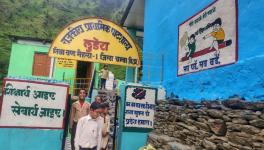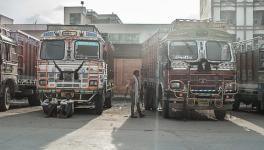HP: Malana Dam Gates Still not Operational, Govt. Must Ensure Safety in Hydropower Projects
Malana Dam. Image Courtesy: Twitter/@dprhp
Floods in Himachal Pradesh have also brought the issue of hydropower dams into focus. Malana hydropower project in Kullu district is currently in the news for still being unable to open the dam gates, which have been blocked by the considerable muck and debris upstream.
It has been over a week, but the gates are still not operational. This has further reinforced the debate in the Himalayan region over the interconnection between hydropower projects and their impact on the entire ecosystem.
The Malana hydropower project is a privately run entity generating 86 MW of electricity, owned by a joint venture of two private players, Bhilwara Energy Limited (51% share) and Statkraft-Norway (49%). There are several hydropower projects in Himachal Pradesh being run by private players; notable amongst them are Wangtoo Karcham 1000 MW, built by Jaypee, now taken over by the Jindals, likewise Baspa project -330MW owned by the same company. Then there are micro-hydropower projects constructed by private players, also called Independent Power Producers(IPPs).
All the IPP hydropower projects are run with a run-of-the-river dam technology, which means these are not large dams. However, malfunction of the dams or their gates being locked can create a cascading effect downstream.
There are more than 20 hydropower dams in the state.
Dam Safety Audit
The Dam Safety Act 2021 resulted from more than three decades of discussions and deliberations between the central and state governments. It aims to prevent dam failure-related disasters through regular surveillance, inspection, operation and maintenance. It also establishes the necessary institutional mechanism for this purpose. India is third in the list(5701 dams), after China and US, in the total number of dams.
The Dam Safety Act has laid down guidelines for standard operating procedures and surveillance mechanisms of dams. At the national level, there is a central team which is further compounded by state-level teams comprising technical staff called the State Dam Safety Organisation (SDSO), chaired by an engineer.
In Himachal Pradesh, the SDSO was notified in June 2022 and is headed by a chief engineer. The task of the SDSO is to keep perpetual surveillance, carry out inspections, and monitor the operation and maintenance of all specified dams falling under their jurisdiction to ensure the continued safety of such dams and take measures as may be necessary to address safety concerns.
The Dam Safety Act also categorically specifies that the SDSO’s responsibilities also include vulnerability classification of dams, maintenance of log books, maintaining records of dam failures and dam incidents, giving instructions to dam owners on safety/remedial measures, inspection and investigation etc.
How was the SDSO functioning over nearly a year in Himachal Pradesh? Have they ever visited some of the vulnerable dams, which have been pointed out repeatedly by the people or some of the media reports regarding the urgent necessity for intervention?
Dam Safety Concerns Raised in the Past
In January 2016, five years before the Dam Safety Act came into existence, the then Himachal Pradesh state government was apprised of the safety concerns in the hydropower and dams. It was decided then to “avoid untoward incidents in hydropower projects; the Himachal Pradesh government decided to conduct safety audit of every project.”
How many such audits were done? No one is aware of it. And if at all such audits were done, what would be the outcome? Not a single hydropower project has either been indicted or penalised because of dams. However, there have been several dam failures leading to the loss of lives and assets.
In May 2020, once again, the safety issue in hydropower dams was pointed out, and the hydropower projects were categorised in the ‘red’ category in Himachal Pradesh from the hazard vulnerability perspective.
On May 16, 2020, there was a major accident at the Uhl- stage III Hydropower Project in Mandi after the penstock pipe burst during a trial run of the project.
Dam Owners Responsibility and Liability
Not just the SDSOs, but even the dam owners are responsible under the Dam Safety Act. The Act casts a number of obligations on the dam owners. As per the Act, they will be responsible for the safe construction, operation, maintenance and supervision of the dam. They must establish a Dam Safety Unit, which shall inspect the dams before and after the monsoon, during and after events like earthquakes, floods, etc., or during and after any sign of distress. Further, the dam owners are obligated to complete technical documentation, installation of monitoring instruments, establishment of the hydrometeorological station, installation of seismological station (for dams of height 30 meters or above), preparation of emergency action plan, carry out risk assessment studies, preparation of a comprehensive dam safety evaluation through an independent panel of experts.
The safety evaluation of the dams must be done through an independent panel and not through the internal review panel constituted by the dam owner.
Register criminal complaint
The Act also provides the provision for registering a criminal complaint under sections 41-44 of the Dam Safety Act. The SDSO or the government agencies also owe a vicarious liability and should be brought under the radar of reasonable questioning.
The Act specifies the vicarious liability of the SDSOs. The Act makes the heads of government departments and the persons in charge of companies vicariously liable for offences committed under the Act(Section 42, 43).
The SDSO is supposed to prepare annual reports within three months of the expiry of the preceding financial year or its activities and the safety status of specified dams in the state. These reports are not in the public domain, and there are doubts about whether the SDSO has even made such reports.
It is unclear when the gates of Malana will open. However, we are sure that if the dam safety concerns are left at bay, this will seriously affect the overall ecosystem comprising the humans and the biodiversity around. It is high time that the state government must step forward, empower the SDSO, start dam audits, and follow the protocols in earnest.
The writer is former Deputy Mayor of Shimla, Himachal Pradesh. The views are personal.
Get the latest reports & analysis with people's perspective on Protests, movements & deep analytical videos, discussions of the current affairs in your Telegram app. Subscribe to NewsClick's Telegram channel & get Real-Time updates on stories, as they get published on our website.
























